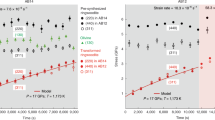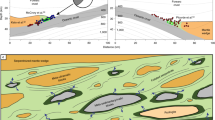Abstract
The convective circulation generated within the Earth’s mantle by buoyancy forces of thermal and compositional origin is intimately controlled by the rheology of the rocks that compose it. These can deform either by the diffusion of point defects (diffusion creep, with a linear relationship between strain rate and stress) or by the movement of intracrystalline dislocations (nonlinear dislocation creep)1,2. However, there is still no reliable map showing where in the mantle each of these mechanisms is dominant, and so it is important to identify regions where the operative mechanism can be inferred directly from surface geophysical observations. Here we identify a new observable quantity—the rate of downstream decay of the anomalous seafloor topography (swell) produced by a mantle plume—which depends only on the value of the exponent in the strain rate versus stress relationship that defines the difference between diffusion and dislocation creep. Comparison of the Hawaiian swell topography with the predictions of a simple fluid mechanical model shows that the swell shape is poorly explained by diffusion creep, and requires a dislocation creep rheology. The rheology predicted by the model is reasonably consistent with laboratory deformation data for both olivine3 and clinopyroxene4, suggesting that the source of Hawaiian lavas could contain either or both of these components.
This is a preview of subscription content, access via your institution
Access options
Subscribe to this journal
Receive 51 print issues and online access
$199.00 per year
only $3.90 per issue
Buy this article
- Purchase on Springer Link
- Instant access to full article PDF
Prices may be subject to local taxes which are calculated during checkout



Similar content being viewed by others
References
Poirier, J.-P. Creep of Crystals (Cambridge University Press, 1985)
Karato, S.-I. Deformation of Earth Materials (Cambridge University Press, 2008)
Keefner, J. W., Mackwell, S. J., Kohlstedt, D. L. & Heidelbach, F. Dependence of the creep of dunite on oxygen fugacity: implications for viscosity variations in Earth’s mantle. J. Geophys. Res. doi:10.1029/2010JB00748. (in the press)
Bystricky, M. & Mackwell, S. Creep of dry clinopyroxene aggregates. J. Geophys. Res. 106, 13443–13454 (2001)
Bai, Q., Mackwell, S. & Kohlstedt, D. L. High-temperature creep of olivine single crystals. 1. Mechanical results for buffered samples. J. Geophys. Res. 96, 2441–2463 (1991)
Peltier, W. R. Glacial isostatic adjustment. 2: Inverse problem. Geophys. J. R. Astron. Soc. 46, 669–705 (1976)
Hager, B. H., Clayton, R. W., Richards, M. A., Comer, R. P. & Dziewonski, A. M. Lower mantle heterogeneity, dynamic topography and the geoid. Nature 313, 541–545 (1985)
Mitrovica, J. X. & Forte, A. M. A new inference of mantle viscosity based upon joint inversion of convection and glacial isostatic adjustment data. Earth Planet. Sci. Lett. 225, 177–189 (2004)
Karato, S. Jung. H., Katayama, I. & Skemer, P. Geodynamic significance of seismic anisotropy of the upper mantle: new insights from laboratory studies. Annu. Rev. Earth Planet. Sci. 36, 59–95 (2008)
Montagner, J. P. & Tanimoto, T. Global upper mantle tomography of seismic velocities and anisotropies. J. Geophys. Res. 96, 20337–20351 (1991)
Long, M. D. & Silver, P. G. Shear wave splitting and mantle anisotropy: measurements, interpretations, and new directions. Surv. Geophys. 30, 407–461 (2009)
Wilson, J. T. A possible origin of the Hawaiian islands. Can. J. Phys. 41, 863–870 (1963)
Morgan, W. J. Convection plumes in the lower mantle. Nature 230, 42–43 (1971)
Montelli, R. et al. Finite-frequency tomography reveals a variety of plumes in the mantle. Science 303, 338–343 (2004)
Wolfe, C. J. et al. Mantle shear-wave velocity structure beneath the Hawaiian hot spot. Science 326, 1388–1390 (2009)
Watts, A. B. & Cochran, J. R. Gravity anomalies and flexure of the lithosphere along the Hawaiian-Emperor Seamount Chain. Geophys. J. R. Astron. Soc. 38, 119–141 (1974)
Tarduno, J. A. et al. The Emperor seamounts: southward motion of the Hawaiian hotspot plume in Earth’s mantle. Science 301, 1064–1069 (2003)
Davies, G. F. Temporal variation of the Hawaiian plume flux. Earth Planet. Sci. Lett. 113, 277–286 (1992)
Olson, P. in Magma Transport and Storage (ed. Ryan, M. ) 33–51 (John Wiley, 1990)
Ribe, N. M. & Christensen, U. Three-dimensional modelling of plume-lithosphere interaction. J. Geophys. Res. 99, 669–682 (1994)
Marks, K. M. & Sandwell, D. T. Analysis of geoid height versus topography for oceanic plateaus and swells using nonbiased linear regression. J. Geophys. Res. 96, 8045–8055 (1991)
Cserepes, L., Christensen, U. & Ribe, N. M. Geoid height versus topography for a plume model of the Hawaiian swell. Earth Planet. Sci. Lett. 178, 29–38 (2000)
van Hunen, J., Zhong, S., Shapiro, N. M. & Ritzwoller, M. H. New evidence for dislocation creep from 3-D geodynamic modeling of the Pacific upper mantle structure. Earth Planet. Sci. Lett. 238, 146–155 (2005)
Sleep, N. H. Hotspots and mantle plumes: some phenomenology. J. Geophys. Res. 95, 6715–6736 (1990)
Ribe, N. M. & Christensen, U. The dynamical origin of Hawaiian volcanism. Earth Planet. Sci. Lett. 171, 517–531 (1999)
Hirth, G. & Kohlstedt, D. L. Water in the oceanic upper mantle: implications for rheology, melt extraction and the evolution of the lithosphere. Earth Planet. Sci. Lett. 144, 93–108 (1996)
Karato, S.-I. Insights into the nature of plume-asthenosphere interaction from central Pacific geophysical anomalies. Earth Planet. Sci. Lett. 274, 234–240 (2008)
Sobolev, A. V., Hofmann, A. W., Sobolev, S. V. & Nikogosian, I. K. An olivine-free mantle source of Hawaiian shield basalts. Nature 434, 590–597 (2005)
Smith, W. H. F. & Sandwell, D. T. Global seafloor topography from satellite altimetry and ship depth soundings. Science 277, 1956–1962 (1997)
Stein, C. & Stein, S. A model for the global variation in oceanic depth and heat flow with lithospheric age. Nature 359, 123–129 (1992)
Christensen, U. & Harder, H. 3-D convection with variable viscosity. Geophys. J. Int. 104, 213–226 (1991)
Herzberg, C. & Asimow, P. D. Petrology of some oceanic island basalts: PRIMELT2.XLS software for primary magma calculation. Geochem. Geophys. Geosyst. 9, Q09001 (2008)
Kirby, S. H. Rheology of the lithosphere. Rev. Geophys. 21, 1458–1487 (1983)
Borch, R. S. & Green, H. W., II Deformation of peridotite at high pressure in a new molten salt cell: comparison of traditional and homologous temperature treatments. Phys. Earth Planet. Inter. 55, 269–276 (1989)
Acknowledgements
We thank A. Davaille, C. Herzberg, S.-I. Karato and D. Kohlstedt for discussions and advice. This work was supported by the French embassy in Tehran and by the SEDIT programme of INSU and the ANR (grant PTECTO) in France.
Author information
Authors and Affiliations
Contributions
N.A. derived the lubrication equation, determined the similarity solution and the full numerical solutions of that equation, and analysed the topography data. N.M.R. proposed the idea for the study, determined the three-dimensional numerical solutions with temperature-dependent rheology, and wrote the manuscript. F.S. co-directed the parts of the work done in Zanjan. All authors discussed the results and commented on the manuscript.
Corresponding authors
Ethics declarations
Competing interests
The authors declare no competing financial interests.
Supplementary information
Supplementary Figures
This file contains Supplementary Figures 1-3 with legends. Supplementary Figure 1 shows the validation of the lubrication-theory model against a three-dimensional convection model with temperature-and pressure-dependent viscosity (Newtonian rheology). Supplementary Figure 2 shows the validation of the lubrication-theory model against a three-dimensional convection model with temperature-pressure-, and strain-rate dependent viscosity (non-Newtonian rheology, power-law exponent 3.5). Supplementary Figure 3 shows the comparison of the lubrication model predictions with power-law index 4.7 (appropriate for clinopyroxene) with the residual topography of the Hawaiian swell. (PDF 539 kb)
Rights and permissions
About this article
Cite this article
Asaadi, N., Ribe, N. & Sobouti, F. Inferring nonlinear mantle rheology from the shape of the Hawaiian swell. Nature 473, 501–504 (2011). https://doi.org/10.1038/nature09993
Received:
Accepted:
Published:
Issue Date:
DOI: https://doi.org/10.1038/nature09993
Comments
By submitting a comment you agree to abide by our Terms and Community Guidelines. If you find something abusive or that does not comply with our terms or guidelines please flag it as inappropriate.



